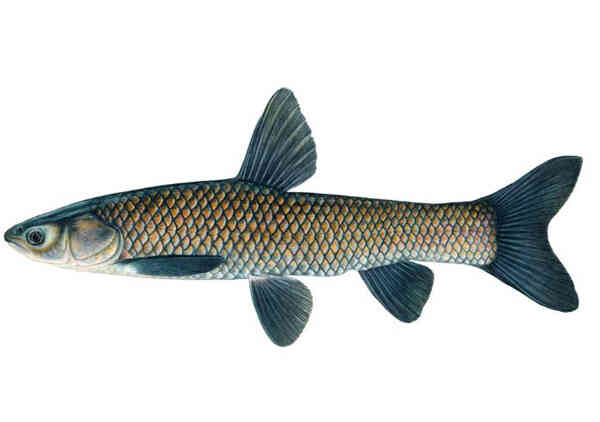
Alias Mylopharyngodon piceus,Black carp,Black mackerel, blue carp, black carp, stream fish, black fish, black fish, snail fish, black fin
Family Cypriniformes Cyprinidae Herring
The black carp is not as active as the grass carp, but it is much stronger than the grass carp. Black carp is a carnivorous fish. Its main food source is mollusks at the bottom of the water, especially snail meat, so it is also called snail green. Black carp also eats clams, mussels, shrimps, dragonflies, larvae, water bugs, etc. In artificial fish farms, black carp naturally feeds mainly on artificial granular plant bait. Bran, bran powder, cooked sweet potatoes, bean powder, rice grains, and green grass are also baits for black carp.

Black carp has different food requirements in different growth stages. For example, young black carp fry mainly feed on zooplankton; in the juvenile stage, they mainly feed on benthic animals, dragonfly larvae, chironomids, etc. When the fish grow up, people mostly feed black carp with silkworm pupae, corn, bean cakes, bean dregs, and fermented glutinous rice.
Black carp has teeth, which are located in the pharynx of the mouth, also called pharyngeal teeth. When encountering shelled animals such as snails, clams, and cockles, it can use its pharyngeal teeth to break the hard shells, spit out the hard shells, and eat the meat inside the shells. Black carp has a strong appetite in spring, summer, and autumn, especially in autumn, when black carp is particularly greedy.
Black carp is a migratory fish. It grows and develops in the water bodies of rivers and enters rivers to hibernate in winter. After the spring, the overwintering black carp migrate upstream and their gonads rapidly develop to maturity during the upstream migration. They reproduce in the spawning grounds of the main stream of rivers and then enter the affiliated water bodies for fattening. The breeding season is from May to June every year, and the water temperature is required to be 18 to 28℃. When the spawning grounds are flooded, the water flow rate is 1 to 2 meters, and the flow pattern becomes chaotic, black carp begins to spawn. Black carp eggs float and hatch and develop with the water flow. The age of sexual maturity of black carp is: female fish 5 to 7 years old, male fish 4 to 5 years old. Spawning type: The gonads of sexually mature individuals mature once a year and spawn once. The amount of eggs carried by black carp increases significantly with the increase of body weight. Generally, a black carp weighing 15 to 20 kg carries about 600,000 to 1 million eggs.
Black carp meat is sweet, flat and non-toxic. It has the effects of replenishing qi and deficiency, strengthening the spleen and stomach, nourishing the liver and improving eyesight, removing dampness and harmonizing the middle, and stopping malaria. It can be used to treat spleen and stomach weakness, beriberi and dampness, depression, malaria, hematuria and other diseases; its gallbladder is bitter, cold and toxic. It has the effects of purging heat, reducing inflammation, improving eyesight and removing cataracts. It is mainly used for external treatment of red and swollen eyes, conjunctivitis, cataract throat paralysis, sudden deafness, malignant sores, white baldness and other diseases. It is mainly used for internal treatment of tonsillitis.
Black carp contains carbohydrates, multiple vitamins, zinc, calcium, phosphorus, iron, magnesium and other minerals. Black carp is rich in trace elements such as selenium and iodine. Black carp also contains eicosapentaenoic acid (EPA) and docosahexaenoic acid (DHA).
The nucleic acid rich in black carp meat is a substance necessary for human cells, which can delay aging and assist in the treatment of diseases. Black carp is rich in trace elements such as selenium and iodine, which can help maintain the normal replication of cells, strengthen immune function, delay aging and inhibit tumors.
Black carp is one of the four traditional freshwater farmed fish in China.